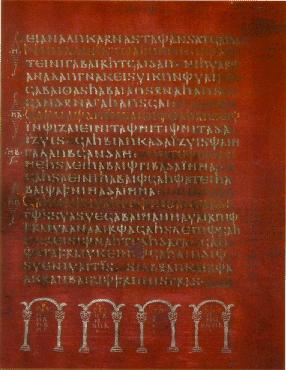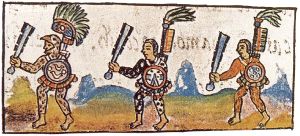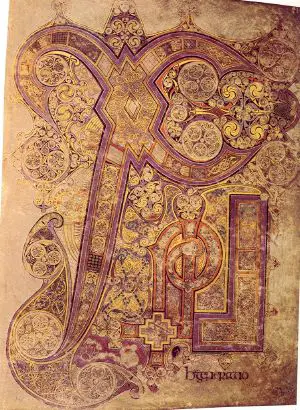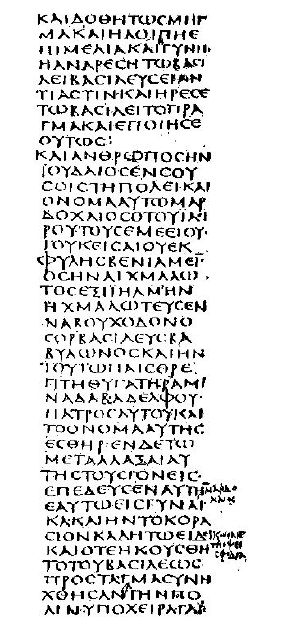Difference between revisions of "Codex" - New World Encyclopedia
(article ready) |
Keisuke Noda (talk | contribs) |
||
| Line 143: | Line 143: | ||
[[Category:History]] | [[Category:History]] | ||
[[Category:Literature]] | [[Category:Literature]] | ||
| − | + | [[Category:Library and information science]] | |
| − | {{credits| | + | {{credits|Codex|240708365}} |
Revision as of 01:26, 8 October 2008
A codex (Latin for block of wood, book; plural codices) is a book in the format used for modern books, with separate pages normally bound together and given a cover. It was a Roman invention that replaced the scroll, which was the first form of book in all Eurasian cultures.
Although technically any modern paperback is a codex, the term is only used for manuscript (hand-written) books, produced from Late Antiquity through the Middle Ages. The scholarly study of manuscripts from the point of view of the bookmaking craft is called codicology. The study of ancient documents in general is called paleography.
New World codices were written as late as the sixteenth century (see Maya codices and Aztec codices). Those written before the Spanish conquests seem all to have been single long sheets folded concertina-style, sometimes written on both sides of the local amatl paper. They are therefore strictly speaking not actually in codex format, although they more consistently have "Codex" in their usual names than other types of manuscript.
The codex was an improvement upon the scroll, which it gradually replaced, first in the West, and much later in Asia. The codex in turn became the printed book, for which the term is not used. In China, because books were already printed, but only on one side of the paper, there were intermediate stages, such as scrolls folded concertina-style and pasted together at the back.[1]
History
The Romans used similar precursors made of reusable wax-covered tablets of wood for taking notes and other informal writings. The first recorded use of the codex for literary works dates from the late first century AD, when Martial experimented with the format. At that time the scroll was the dominant medium for literary works and would remain dominant for secular works until the fourth century. Julius Caesar, traveling in Gaul, found it useful to fold his scrolls concertina-style for quicker reference[citation needed], as the Chinese also later did. As far back as the early 2nd century, there is evidence that the codex—usually of papyrus—was the preferred format among Christians: in the library of the Villa of the Papyri, Herculaneum (buried in AD 79), all the texts (Greek literature) are scrolls; in the Nag Hammadi "library," secreted about AD 390, all the texts (Gnostic Christian) are codices. The earliest surviving fragments from codices come from Egypt and are variously dated (always tentatively) towards the end of the 1st century or in the first half of the 2nd. This group includes the Rylands Library Papyrus P52, containing part of St John's Gospel, and perhaps dating from between 125 and 160.[2][3]
In Western culture the codex gradually replaced the scroll. From the fourth century, when the codex gained wide acceptance, to the Carolingian Renaissance in the eighth century, many works that were not converted from scroll to codex were lost to posterity. The codex was an improvement over the scroll in several ways. It could be opened flat at any page, allowing easier reading; the pages could be written on both recto and verso; and the codex, protected within its durable covers, was more compact and easier to transport.
The codex also made it easier to organize documents in a library because it had a stable spine on which the title of the book could be written. The spine could be used for the incipit, before the concept of a proper title was developed, during medieval times.
Although most early codices were made of papyrus, papyrus was fragile and supplies from Egypt, the only place where papyrus grew, became scanty; the more durable parchment and vellum gained favor, despite the cost.
The codices of pre-Columbian Mesoamerica had the same form as the European codex, but were instead made with long folded strips of either fig bark (amatl) or plant fibers, often with a layer of whitewash applied before writing.
In Asia, the scroll remained standard for far longer than in the West. The Jewish religion still retains the Torah scroll, at least for ceremonial use.
Notable codices
Codices are usually named for their most famous resting-place, whether a city or a private library. N.B.: this is mostly a list of notable books that happen to have Codex in their usual name, as opposed to e.g. Gospels, Bible etc. Most of the books in the List of manuscripts and List of illuminated manuscripts are also codices.
- Codex Abrogans Latin, Old High German 8th c. 765–775
- Codex Alexandrinus
- Aleppo Codex
- Codex Ambrosianus: A, B, C, D, E,
- Codex Amiatinus
- Codex Argenteus
- Arnamagnæan Codex
- Codex Astensis
- Auraicept na n-Éces
- Codex Aureus of St. Emmeram
- Codex Aureus of Lorsch
- Codex Berolinensis
- Codex Bezae
- Codex Borbonicus
- Burana Codex
- codex Boturini [1]
- Codex Cairensis also: Codex Prophetarum Cairensis, Cairo Codex of the Prophets
- Codex Claromontanus
- Cortesianus Codex
- Codex Cumanicus
- De arte venandi cum avibus
- Codex Ephraemi Rescriptus
- Codex Exoniensis
- Codex Flatoiensis
- Codex Gigas
- Codex Grandior
- Codex Hierosolymitanus
- Hypatian Codex 15ct OCS
- In Lebor Ogaim
- Codex Koridethi
- Leabhar Bhaile an Mhóta 1390 or 1391
- Lebor Gabála Érenn 11th c
- Lebor na gCeart before 1418
- Codex Leicester
- Leningrad Codex
- Codex Manichaicus Coloniensis
- Madrid Codex
- Codex Manesse
- Codex Mecelle
- Codex Mendoza
- Codex Montepessulanus H54 (M) 11th c [2]
- Morgan Bible 1240
- Codex ms. 3227a
- MS No. 7117 from the Erevan Matenadaran
- Novgorod Codex
- Nowell Codex
- Paris Codex
- Peterborough Chronicle
- Codex Pisanus
- Codex Rehdigerianus
- Codex Regius
- Rohonc Codex, a.k.a. Rohonci-kódex, or Rohonczi Codex
- Codex Runicus 1300
- Codex Sangallensis 878
- Codex Sinaiticus
- Codex Suprasliensis
- Codex Tchacos
- Troano Codex
- Codex Usserianus Primus
- Codex Vaticanus
- Codex Vigilanus written in Spain in the year of 976
- Codex Vindobonensis 795
- Codex Vindobonensis B 11093
- Codex Vindobonensis 3256 [3]
- Codex Vindobonensis Mexicanus 1 [4]
- Codex Wallerstein
- Codex Zamoscianus
- Codex Zouche-Nuttall
- Nag Hammadi library, a collection of early Christian Gnostic texts in codex form discovered in the town of Nag Hammadi.
- Book of Kells, a set of Gospels from the 8th or 9th century.
- Lucca Codex, 1220s, Biblioteca Statale, Lucca, Italy)
- Codex Augiensis (F 010) [5]
- Codex Boernerianus (G 012)
- Codex Carolinus
- Codex Gissensis
- Codex Parisinus
- Peresianus Codex
- Codex Suprasliensis
- Codex Taurinensis
- Grolier Codex
- Codex Constitutionum
- Codicula Atlantico by Leonardo 1478 to 1519.
See also
- Aztec codices
- Codex Alimentarius The international food code
- Codex Seraphinianus
- Inscription
- List of New Testament papyri
- List of New Testament uncials
- Manuscript culture
- Maya codices
- Papyri (chronology)
- Philology
- Traditional Chinese bookbinding
Notes
- ↑ Colin Chinnery, International Dunhuang Project - Several intermediate Chinese bookbinding forms from the C10th. Retrieved December 5, 2007.
- ↑ Turner, Eric Gardiner. The typology of the early codex. 1977. OCLC 163948432
- ↑ Roberts, Colin H., and Theodore C. Skeat. The Birth of the Codex. London: Oxford Univ. Press, 1989. ISBN 0197260616
ReferencesISBN links support NWE through referral fees
- Hanson, K.C. , "Catalogue of New Testament Papyri & Codices 2nd—10th Centuries". Retrieved December 5, 2007.
External links
All links Retrieved December 5, 2007.
- "The Codex and Canon Consciousness" - Draft paper by Robert Kraft on the change from scroll to codex.
- The Construction of the Codex In Classic- and Postclassic-Period Maya Civilization - Maya Codex and Paper Making
- "Scroll and codex", Encyclopaedia Romana.
Credits
New World Encyclopedia writers and editors rewrote and completed the Wikipedia article in accordance with New World Encyclopedia standards. This article abides by terms of the Creative Commons CC-by-sa 3.0 License (CC-by-sa), which may be used and disseminated with proper attribution. Credit is due under the terms of this license that can reference both the New World Encyclopedia contributors and the selfless volunteer contributors of the Wikimedia Foundation. To cite this article click here for a list of acceptable citing formats.The history of earlier contributions by wikipedians is accessible to researchers here:
The history of this article since it was imported to New World Encyclopedia:
Note: Some restrictions may apply to use of individual images which are separately licensed.



